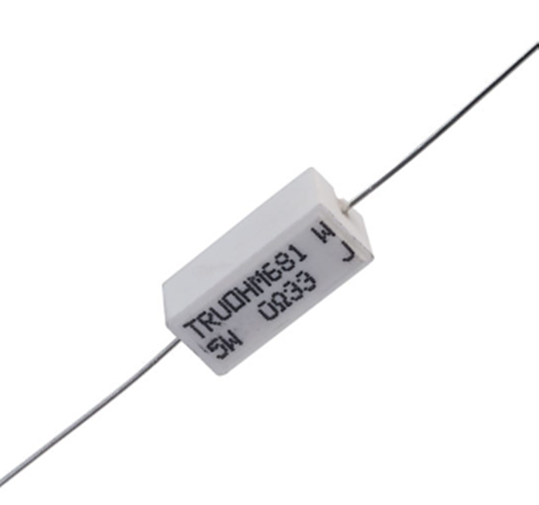Resistors are found in almost all electronic circuits, with the main purpose of controlling the amount of current that flows through a particular part of a circuit.
All conducting materials have the properties of resistance, a length of copper wire for example, but resistors are devices that are manufactured to have specific resistance values.
Low power resistors are usually identified by the colured bands along their length.
When current flows through any condutor it heats up, high power resistors are able to pass high current without being damaged. They are usually made by winding a resistive wire (nichrome) around a ceramic insulator.

Carbon and metal film resistors

Wirewound
resistor

Resistor symbol

Surface mount
resistor
Most common resistors, such as carbon and metal film types, are small. It would therefore be difficult to print text on them to indicate their resistance.
Instead, coloured bands are used to identify resistor values, with each colour representing a number.
The first two bands identify the first two digits of the resistance.
The third band is the multiplier, which tells you how many zeros to add.
The fourth band is the tolerance which indicates the accuracy of the resistor value.
The resistor shown to the right has a resistance of 100 Ω with a tolerance of +/- 5%. This means that the resistor can be expected to have an actual resistance of between 95 Ω and 105 Ω.

The resistor shown above has a resistance of 100Ω with a 5% tolerance
Metal film resistors are manufactured to higher accuracy and therefore need more bands to show a more accurate resistance.
Decoding the resistances works in just the same way as the three band resistors:
The first three bands identify the first three digits of the resistance.
The fourth band is the multiplier, which tells you how many zeros to add.
The fifth band is the tolerance.
The resistor shown above here has a resistance of 1000 Ω or 1KΩ with a tolerance of +/- 1%. This means that the resistor can be expected to have an actual resistance of between 990Ω and 1010Ω.

The resistor shown here has a resistance of 1KΩ with a tolerance of 1%
It is impossible for every single possible resistor value to be manufactured. Instead a specific range of resistor values are available
. For example, you may need a 101.543 Ω resistor in a design, but would have to chose the closest (100 Ω) instead.
The table shows the preferred values for the E24 series of resistors. This means that there are 24 standard values across 7 decades.
There are also other preferred value series available too:
The E12 series consists of 12 standard values. Usually 10% carbon composite types. The E48 series consists of 48 standard values. These are usually metal film resistors with tighter tolerances. The E96 and E192 series also exist for resistors with high tolerances (ie. 1%. 0.5% and 0.25%).

Electronic devices are becoming smaller as time progresses, and this is only possible through the development of surface mount technology.
Surface mounted components are soldered directly onto a circuit board with no requirements for holes to be drilled.
They are significantly smaller than conventional through-hole types and are electronics using this technology are usually not soldered by hand.


Reading SMD resistance values is similar to through-hole components.
The first two digits give the first number and the third is the multiplier telling you how many zeros to add to the end.
This resistor has a resistance of 100000Ω or 100KΩ.

Where the resistor has four digits the first three digits give you the first number and the fourth is the multiplier.
This resistor has a resistance of 47000Ω or 47KΩ.
Using the resistor colour code, work out the resistance values of each of the resistors shown in the animation below. Each image is visible for 10 seconds. To see if you are correct click on the Answers tab above.

Using the resistor colour code, work out the resistance values of each of the resistors shown in the animation below. Each image is visible for 5 seconds only! To see if you are correct click on the Answers tab above.

| Resistor number | Value |
| 1 | 100 |
| 2 | 1k |
| 3 | 10k |
| 4 | 100K |
| 5 | 310 |
| 6 | 3K3 |
| 7 | 33K |
| 8 | 220 |
| 9 | 2K2 |
| 10 | 22K |
| Resistor number | Value |
| 11 | 220K |
| 12 | 330K |
| 13 | 400 |
| 14 | 4K |
| 15 | 1M |
| 16 | 7K2 |
| 17 | 8k2 |
| 18 | 90K |
| 19 | 920K |
| 20 | 7K6 |
| Resistor number | Value |
| 21 | 670K |
| 22 | 840 |
| 23 | 920 |
| 24 | 620 |
| 25 | 62 |
| 26 | 540 |
| 27 | 1M8 |
| 28 | 560K |
